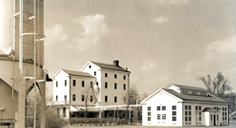Investor News
Investor RelationsVillage Industries Program
Henry Ford turned the American economy upside down with his moving-assembly-line approach to building automobiles, which offered high wages and drew young men from rural areas to the city. But Ford’s feelings about the positive aspects of rural living were so strong that he established small, nondisruptive industrial centers in rural areas of Michigan. These "Village Industries" brought local residents the economic advantages of industrial jobs without having to flee to city life.

Bringing the Factory to the City
Since farming has traditionally been a spring-to-autumn endeavor, Henry Ford developed the Village Industries program to augment and stabilize the income flow of farm workers during the winter. Through the program, he built small factories to make parts and other components for Ford vehicles. In doing so, he was able to bring the factory to the countryside.
As a result of his belief in using clean and readily available sources of energy, hydroelectric power was used to power the Village Industries factories.
Hydroelectric-powered Factories
The first Village Industry site was a small plant built in 1919-20 in Northville, Michigan, on the banks of the Rouge River. An old gristmill stood on the site, and it was reconfigured into a factory to manufacture valves for Ford automobile engines.
Over the next 20 years, more than 30 Village Industries plants sprouted throughout Michigan, Ohio, Mississippi, New York and other states. All were on the banks of rivers, and many were on the sites of abandoned gristmills, which had used river power to turn their waterwheels.
Each plant employed about 100 workers, although some, such as the Green Island, New York, plant on the Hudson River, employed close to 1,000. The various plants made copper welding rods, lamp assemblies, wheels, parts of tractors and more. Today, many people in these towns view the Village Industries program as an ingenious opportunity for their forebears.
Investor News
-

Ford Motor Company’s August Sales Up 11 Percent; Ford Brand Cars, Utilities, Trucks Increase, Along with Lincoln
September 01, 2011 -

Ford, Toyota to Collaborate on Developing New Hybrid System for Light Trucks, SUVs; Future Telematics Standards
August 22, 2011 -

Ford Continues China Expansion, Sales Up 13% This Year
August 11, 2011 -

Ford Drops Price of SYNC by $100, Making Hands-Free, Voice-Activated In-Car Connectivity More Affordable, Available to All
August 01, 2011
Financial Reports
 Annual Report 2010
Annual Report 2010
|
FLIP-BOOK* | |
|---|---|---|
| Flip-Book | ||
| *Interactive flip-book format requires Flash Player |
||
- Investor Resources
- Contact Us




